Grand Canyon Railway and RV Park - Williams, AZ
Many
people remember the road trip adventures they took as children in the backseats
of the family car along Route 66. The nostalgia of yesteryear’s adventures brings
them back to Wigwam Village in Holbrook, AZ. and gives them a piece of western
U.S. culture they remember from their youth.


A rest area between Show Low and Williams on I-40 had this sign posted. Lisa walks with her head on a swivel looking for snakes and critters. The park rangers shared with us that the rattle snakes started coming out from their winter slumber this week. Great.....
____________________
The Grand Canyon is
a steep-sided canyon carved by the Colorado River in Arizona. The Grand Canyon is 277 miles long, up to 18 miles wide and maintains a
depth of over a mile (6,093 feet).
The canyon and adjacent rim are contained within Grand
Canyon National Park, the Kaibab National Forest, Grand
Canyon–Parashant National Monument, the Hualapai Indian Reservation, the Havasupai
Indian Reservation and the Navajo Nation. President Theodore
Roosevelt was a major proponent of the preservation of the Grand Canyon
area and visited it on numerous occasions to hunt and enjoy the scenery.
Nearly two billion years of Earth's geological history have been
exposed as the Colorado River and its tributaries cut their channels through
layer after layer of rock while the Colorado Plateau was uplifted. While
some aspects about the history of incision of the canyon are debated by
geologists, several recent studies support the hypothesis that the
Colorado River established its course through the area about 5 to 6 million
years ago. Since that time, the Colorado River has driven the down-cutting
of the tributaries and retreat of the cliffs, simultaneously deepening and
widening the canyon.
For thousands of years, the area has been continuously inhabited
by Native Americans, who built settlements within the canyon and its many
caves. The Pueblo people considered the Grand Canyon a holy site, and
made pilgrimages to it. The first European known to have viewed
the Grand Canyon was García López de Cárdenas from Spain, who arrived
in 1540.
Even
though it is not the deepest canyon in the world (Kali Gandaki Gorge in Nepal is
much deeper), the Grand Canyon is known for its visually overwhelming size and
its intricate and colorful landscape. Geologically, it is significant because
of the thick sequence of ancient rocks that are well preserved and exposed in
the walls of the canyon. These rock layers record much of the early geologic
history of the North American continent.
Uplift associated with mountain formation later moved these
sediments thousands of feet upward and created the Colorado Plateau. The higher
elevation has also resulted in greater precipitation in the Colorado River
drainage area, but not enough to change the Grand Canyon area from being
semi-arid. The uplift of the Colorado Plateau is uneven, and the Kaibab
Plateau that the Grand Canyon bisects is over one thousand feet higher at
the North Rim than at the South Rim. Almost all runoff from the North Rim
(which also gets more rain and snow) flows toward the Grand Canyon, while much
of the runoff on the plateau behind the South Rim flows away from the canyon
(following the general tilt). The result is deeper and
longer tributary washes and canyons on the north side and shorter and steeper
side canyons on the south side.
Temperatures on the North Rim are generally lower than those on the South Rim because of the greater elevation (averaging 8,000 feet above sea level). Heavy rains are common on both rims during the summer months. Access to the North Rim via the primary route leading to the canyon (State Route 67) is limited during the winter season due to road closures from heavy snows.
We took a trip to the bottom of the Canyon. Records show only about 1% of visitors to the Grand Canyon visit the bottom. To get there, we had to go via a road through the Walapai nation reservation. They charge $17 per person to cross their land. We were on an all day tour that cost us a tad more than that. Ironically, only 20% of the Grand Canyon is owned by the National Parks. The remaining 80% is owned by various Indian Reservations. Many of the Indians live in extreme poverty on the reservations. There is very little work accessible to them in this very isolated barren land. Some have chosen to continue living as their forefathers did- without electricity, indoor plumbing.... We could not even conceptualize living in this extreme summer heat without air conditioning or winters without heat. Many of the homes were basically a shack. The median income for a family of 4 on a reservation is barely over $22,000. The level of poverty and living conditions astounded us. It was like being in a third world country. They live surrounded by some of the most astonishing splendor the world has to offer, yet they live in extreme poverty.


We took a section of Route 66 from Seligman to Peach Spring where the Walapai Market is located.
An old water tank was at the entrance road to the bottom of the Grand Canyon.
Water was cascading down the canyon wall as we descended into the Canyon.
Happy campers riding to the bottom of the Grand Canyon on the tour bus.
These wild burros live on the road to the bottom of the canyon. Their great grandparents were abandoned in the Canyon after mining was stopped in the area. The three are a mama and her 2 daughters. Daddy burro died several years ago. This will be the end of their lineage. Our tour guide stops on the reservation to buy apples daily for them. The burros are used to her giving them apples as she passes by, so they readily came up to our bus. Ironically, this tour was only the second tour of the season. It seemed apparent they remembered her even though there had been no tours since the fall.
We walked the last mile to the bottom of the Canyon. Look at that blue sky! Ironically, we were the last to depart the bus and the first to arrive at the bottom. It appeared the old folks outwalked the youngsters.
These were some of the views saw as we walked to the bottom of the Canyon.
The Colorado river flows through the bottom of the Canyon. The water is very dirty/murky from the snow runoff that is occurring this time of year. The area saw an above average snow fall this year. Things are literally just now rebounding from the winter snow.
They call this The Sleeping Indian. You can see the eye socket, nose and the mouth wide open.
Ocotillo (Coach Whip) spring comes to the bottom of the canyon before it does at the surface. Temperature is typically 15 degree warmer at the bottom of the canyon versus the rim. We saw these same cacti in Big Bend. The ones in Big Bend were blooming when we were there.
We were back in Seligman on Route 66 heading back. We had lunch while we were at the bottom. We would have loved having a few more hours down there since it took us hours and lots of $$$$ to get there, but that was not an option. Our tour group of 10 was the only ones to visit the bottom that day, we had it to ourselves.
We stopped for ice cream in Seligman. This ice cream shop has been part of the lore of Route 66 from the start. The tour guide gave us about 30 minutes to wander around, but it was so cold and windy that everyone went back to the bus to eat their ice cream.
_____________________________________
The city of Sedona is located in the northern Verde Valley region of Arizona.
Sedona's main attraction is its array of red sandstone formations.
The formations appear to glow in brilliant orange and red when illuminated by
the rising or setting sun. The red rocks form a popular backdrop for many
activities, ranging from spiritual pursuits to the hundreds of hiking and
mountain biking trails. There is also a very artsy vibe in the city.
Sedona was named after Sedona Arabella Miller Schnebly (1877–1950),
the wife of Theodore Carlton Schnebly, the city's first postmaster. She was
celebrated for her hospitality and industriousness. Her mother, Amanda
Miller, claimed to have made the name up because "it sounded pretty".
Sedona is a much more affluent area, especially compared to the poverty of the Indian Reservation. The differences were startling. The area was actually very crowded and busy. Parking was a chore. We changed our hiking plans several times because of the crowds. We would have walked further from the car to the trail, than the several miles of the actual trail. We finally found a great place to park and hike. We found out this weekend is known for being one of the busiest of the year.






The road into Sedona from I-15 is challenging to drive with the elevation changes and all of the switchbacks, but it is well worth the drive to see the beauty of the area.
This was our view during our outdoor patio lunch. It was insanely windy and cold outside, but we wanted the full outdoor experience. Another benefit of eating on the patio was we could bring Karma with us. He always has a blast when he gets to go.
Cathedral Rock stands proudly by itself.
Courthouse Butte stands very regally atop this mountain. A Butte
is an isolated hill with steep sides and a small flat top- similar to a Mesa, but smaller.
We hiked to Baby Bell. The colors were much more intense than it appears in pictures.
Karma was taking a water break while we had a snack. One of us typically shares hers with him. He is giving me that indignant look because he seems to think I ate more than I gave him. He typically gets two bites to my one.
We had a great hike- up and down and all around these canyons. We seem to find ourselves in places we previously never dreamed we would be. A year or two ago, no one (including us) would ever have expected me to be hiking up to 10 miles, biking up to 45 miles, and crawling all over these rocks. We have overcome so many trials and tribulations that it makes this journey even more special. Several times a week, I amaze even myself with the things we are doing. It is not always easy and we have to make a few allowances when I feel puny, but we are just so thankful to be working together to make this adventure a reality.
Lisa was showing off her (lack of...) mountaineering skills. She does pretty well as long as she is not required to get too close to the edges.
This formation is named the Courthouse Butte.
This was the east side of Bell Rock.
There are a few Hoodoo's on the east side of Bell Rock. A hoodoo is a tall, thin spire of rock formed by erosion.
Bell Rock stands very regally high atop this mountain.
A few more shots of Bell Rock from various vantage points.
Again, these pictures of the red rocks of Sedona do not do it justice.
Bearizona Wildlife Park, a privately owned zoo, is located on
approximately 160 acres in beautiful Williams, AZ.
Bearizona is dedicated to responsible wildlife management,
conservation, and education. All of the animals are rescues. They fix all of the animals upon their arrival so there is always room to save another rescue, rather than breeding more. They have an amazing staff of very knowledgeable professionals. Most people who work with animals do it for their love of animals, because the pay is typically shockingly low.
You can drive
through over three miles of Ponderosa Pine Forest viewing North American
animals in their natural habitats- most of them roam freely with fences only around the outer perimeter.
Animals are
also exhibited in Fort Bearizona, a 20-acre walk-thru area, along winding paths
which is more of a “zoo” type setting. Snakes were the only animals in a small, confined space. These animals had habitats to roam and live that were substantially larger and nicer than the majority of zoos.
It was suggested to us to make sure we both drive and walk though the areas several times. We were so glad we did. We saw so much more when we made our second trip through the zoo. It was almost a different experience each time.


Dahl Sheep were wandering around their habitat.
This fella walked right up to our car.
Mule Deer have really big ears like a mule.
Juvenile Black Bears are kept separately from the older, more mature bears for their first two years. They were like curious kids and wandered right up to our car.
White buffalo and North American bison roam freely. Several of them wandered right up to our car in the middle of the road.
Adult black bears were kept separately from the younger bears. These fellas seemed oblivious to the cars and people. We had to stop the car several times because the bears were out in the road. One came up and looked into our car window. He did not seem impressed and ambled off when he decided it was time to wander off. He never showed any aggression, but he let us know he would come and go as he desired. Lisa got in trouble when she rolled down her window to get a picture of him. They had gate keepers watching from monitors. As soon as Lisa rolled down her window, the lady spotted her and immediately let her know that the window needed to go back up. Keeping her out of trouble is a full time job.
Lisa was playing Where's Waldo with the wooden sculptures just inside the walk through portion of the zoo.
Tom Turkey was strutting his stuff when he saw he had attracted the attention of a few people. He puffed up and started strutting to put on a show.
The badgers were a bit lazy. They did not share Tom turkey's need to get attention.
The Arctic fox also did not seem to be interested in showing off.
The caribou seemed to enjoy the snow and was doing his own thing.
The racoon put on a show for us.
These two black bears were orphaned while very young. Luckily, someone found them and their dead mama and was able to rescue them. One of them was bossy and the other let her boss him around. They were very attentive to each other.
The otters were having a great time in the water playing with each other.
Lisa found a seat in the bear's lap. I really have to keep an eye on her.
The jaguar was very regal and obviously felt he was the master of his domain.
The reindeer had the same look on his face that Biden gets during a press conference.
The Arctic wolves looked a bit bored and restless.
The timber wolf was on patrol by himself.
The big horn sheep was oblivious to everything except his dinner.
The grizzly bear was sticking out his tongue out on command. They were training the bears for several commands that will help the staff care for them.
The grizzly bear was opening his mouth as directed. He was anxious to do everything they asked him to do so he would get the fish she was giving him as a reward. She only had to tell him once.
The grizzly was standing up for body inspection. They train their grizzly bears with food as a reward. The harder the task, the greater the reward. Raw meat and fish are the rewards for obeying the commands. The actions they do on command allow the veterinarian to do their job without anesthetizing the animal.
The grizzly bears returned to their habitat after the training was completed for the day. They had to work to get the fresh meat by following commands, but the produce was given freely.
The bob cat exuded an air that let the world know he considered himself king.
This is an interesting private park and all of the animals are rescued. They come from abandonment, injury or after being orphaned. All animals are sterilized upon arrival, so they are always available to accept more animals from being euthanized.
_________________________________
We saw the Grand Canyon from the top today. The beauty was literally breath taking when you see this for the first time. Nothing compares to that first instant when you see it for the first time. That first glance is indescribable. The national park controls 27 miles of the Grand Canyon's overall length of 277 miles long. The remainder of the Grand Canyon is controlled by the Walapai Indians.
Lisa gets braver and closer to the edge as time goes on. She did not think I noticed, but I did. She is deathly afraid of ledges and heights.
Look closely and you can see the Colorado River which created all this splendor.
The bridge is used by Rim to Rim hikers and overnight campers.
This was the highlight of the week- Megan and Adrian flew out to see us for a week. Mark, Lisa, Megan and Adrian were standing on the edge of the canyon. Lisa was definitely thrilled to see the kids.
The Colorado River does not look powerful enough to carve out the Grand Canyon, but it did.
We took a train ride to the Grand Canyon Village with Adrian and Megan. The train travels 65 miles and takes 2.5 hours each way. Meg made the reservations for us and booked us in their luxury dome car of the train- which was their premium package. We thought we would be seeing the canyon as we rode the train, but you just see the landscape until you reach the village. We had time to wander around and see the canyon for a few hours before we headed back to the train. Our campground, their hotel and the train were all owned by the same company. Afterwards, we had dinner in a local brewery. It was easy to get around town with many restaurants within walking or a short drive distance.
We spent two days at the Grand Canyon and took an untold number of pictures. Unfortunately, the pictures do not begin to show how majestic the canyon actually is. We were unable to go to the North Rim since it was still closed for winter. The North rim normally opens May 15th. We received notification that due to the abnormal snowfall amount this winter, the North Rim will not be opening until mid June. We learned this has major ramifications to those who desire to do the Rim to Rim hike or the hike across Arizona. With temperatures at the Canyon bottom averaging 20 degrees more than the top, the bottom will see temperatures in the high 90's by mid Junes. Most hikers are unprepared for those temperatures. People have literally died from the heat and dehydration on the trails. Rim to Rim hikers usually do the hikes in May and October. This will negatively impact the economy of the area. Tourism significantly slows down during the heat of summer.
____________________________________________________
The saguaro is a
tree-like, columnar, slow growing cactus species in the monotypic genus Carnegiea that
can grow to be over 40 feet tall. They typically live 150-200 years. It grows notable branches, typically called arms. Not all of them grow arms, but the ones that do grow their first year arm after 75-100 years. Arms are developed to increase the plant's reproductive capacity, as more apices lead to more flowers and fruit. A saguaro can absorb and store considerable amounts of rainwater, visibly expanding in the process, while slowly using the stored water as needed. This characteristic enables the saguaro to survive during periods of drought. It is a keystone species, and provides food and habitat to a large number of species. It is the largest cactus in the United States. It is native to the Sonoran Desert in Arizona,
the Mexican state of Sonora, and the Whipple Mountains and Imperial
County areas of California. The saguaro blossom is the state
wildflower of Arizona. Its scientific name is given in honor of Andrew
Carnegie.
Saguaros have been a source of food
and shelter for humans for thousands of years. Native people, such as the Tohono Oʼodham and Pima, use the fruit to make a syrup.
Their ribs are used as building materials in the wood-poor deserts. The saguaro
cactus is a common image in Mexican and Arizonan culture, and American
Southwest films.
The growth rate of this cactus is
strongly dependent on precipitation. Saguaros in drier western Arizona
grow only half as fast as those in and around Tucson. Saguaros grow slowly
from seed, and may be only a fourth of an inch tall after two years. Cuttings rarely root, and when they do, they do not
go through the juvenile growth phase, which gives it a different appearance. Saguaros are stem
succulents and can hold large amounts of water. When rain is plentiful and
the saguaro is fully hydrated, it can weigh between 3,200 and 4,800 pounds.















The traditional Saguaro, typically seen in the movies, usually has 3 or 4 arms. Those are much more attractive than the ones that have the multiple arms. We didn't count the number of arms on some of these, but several had a dozen or more arms. Seeing these was on our bucket list of must see things.
Our next adventure was to the Arizona Diamondback MLB Field when they played the Los Angeles Dodgers. We got to see the Diamondbacks pull off a big win.
We spent a week in Williams, Arizona. We were the ultimate tourists while we were there with plans every day. There was a lot more to see in the area than just the Grand Canyon. Our trip to the bottom was completely unplanned, but we were very glad we went. We would like to hike to the bottom, but that probably is beyond our skill set at this time. It is a 12 mile hike. Going down is challenging, but going back up is brutal. Maybe sometime in the future.... (hey, we can dream big, right?)
Adrian and Megan are off with us to our next stop at Zion. Lisa is still on cloud 9 having the kids with us.









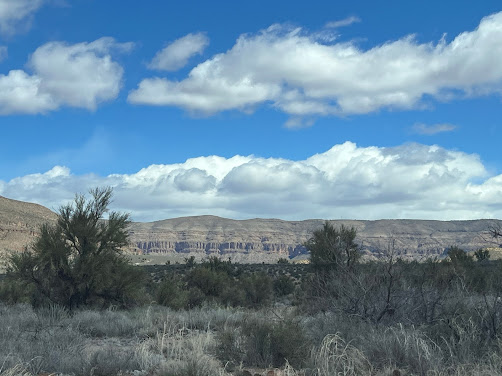


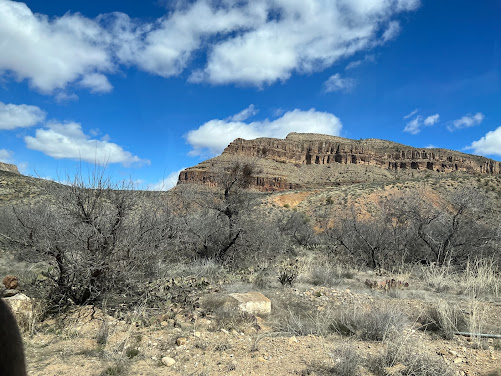
































































































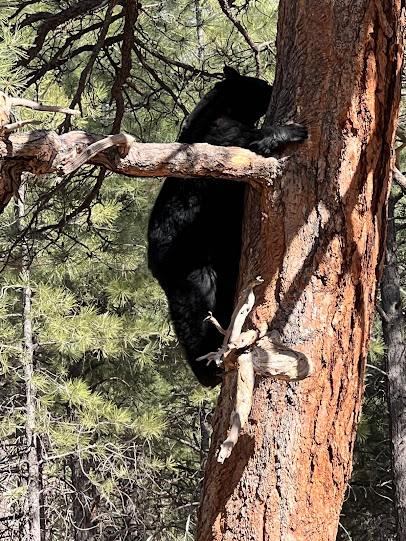


























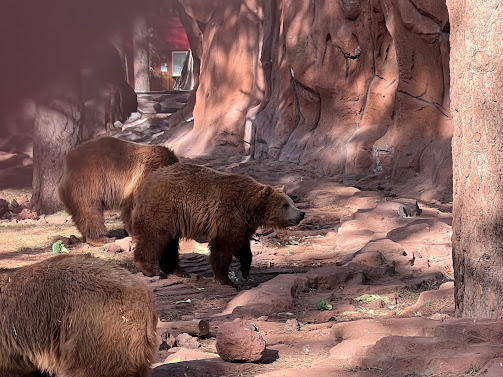


































































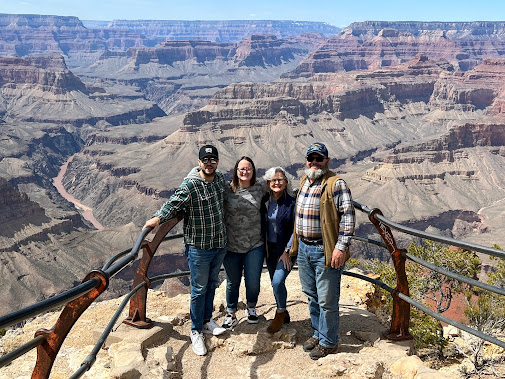



























No comments:
Post a Comment